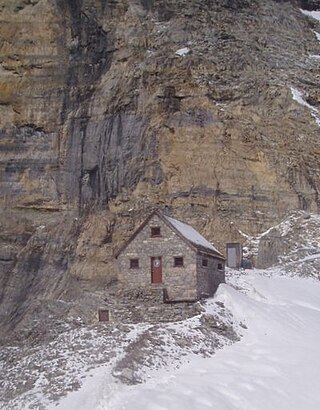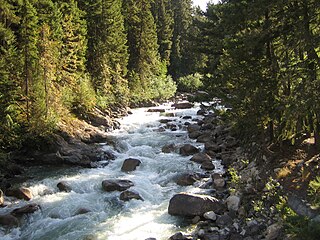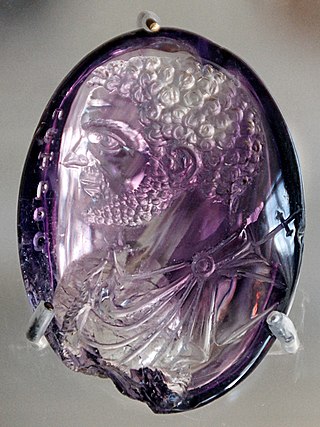
Aegean civilization is a general term for the Bronze Age civilizations of Greece around the Aegean Sea. There are three distinct but communicating and interacting geographic regions covered by this term: Crete, the Cyclades and the Greek mainland. Crete is associated with the Minoan civilization from the Early Bronze Age. The Cycladic civilization converges with the mainland during the Early Helladic ("Minyan") period and with Crete in the Middle Minoan period. From c. 1450 BC, the Greek Mycenaean civilization spreads to Crete, probably by military conquest. The earlier Aegean farming populations of Neolithic Greece brought agriculture westward into Europe before 5,000 BC.

Jewellery consists of decorative items worn for personal adornment, such as brooches, rings, necklaces, earrings, pendants, bracelets, and cufflinks. Jewellery may be attached to the body or the clothes. From a western perspective, the term is restricted to durable ornaments, excluding flowers for example. For many centuries metal such as gold often combined with gemstones, has been the normal material for jewellery, but other materials such as glass, shells and other plant materials may be used.

Lapis lazuli, or lapis for short, is a deep-blue metamorphic rock used as a semi-precious stone that has been prized since antiquity for its intense color. Originating from the Persian word for the gem, lāžward, lapis lazuli is a rock composed primarily of the minerals lazurite, pyrite and calcite. As early as the 7th millennium BC, lapis lazuli was mined in the Sar-i Sang mines, in Shortugai, and in other mines in Badakhshan province in modern northeast Afghanistan. Lapis lazuli artifacts, dated to 7570 BC, have been found at Bhirrana, which is the oldest site of Indus Valley civilisation. Lapis was highly valued by the Indus Valley Civilisation. Lapis beads have been found at Neolithic burials in Mehrgarh, the Caucasus, and as far away as Mauritania. It was used in the funeral mask of Tutankhamun.

Jasper, an aggregate of microgranular quartz and/or cryptocrystalline chalcedony and other mineral phases, is an opaque, impure variety of silica, usually red, yellow, brown or green in color; and rarely blue. The common red color is due to iron(III) inclusions. Jasper breaks with a smooth surface and is used for ornamentation or as a gemstone. It can be highly polished and is used for items such as vases, seals, and snuff boxes. The density of jasper is typically 2.5 to 2.9 g/cm3. Jaspillite is a banded-iron-formation rock that often has distinctive bands of jasper.
Shalmaneser IV was the king of the Neo-Assyrian Empire from 783 BC to his death in 773 BC. Shalmaneser was the son and successor of his predecessor, Adad-nirari III, and ruled during a period of Assyrian decline from which few sources survive. As such his reign, other than broad political developments, is poorly known. Shalmaneser's time was marked both by an increase in the power held by Assyrian officials relative to that of the king and Assyria's enemies growing increasingly powerful. Most of Shalmaneser's military efforts were spent warring against the Kingdom of Urartu in the north, which during this time was reaching the peak of its power.

Antiochus IX Eusebes Cyzicenus was a ruler of the Hellenistic Seleucid kingdom. He was the son of Antiochus VII Sidetes and Cleopatra Thea. He left the kingdom in 129 BC and went to the city of Cyzicus, but he returned in 116 BC to challenge his half-brother Antiochus VIII for power.

Jade is an umbrella term for two different types of decorative rocks used for jewelry or ornaments. Jade is often referred to by either of two different silicate mineral names: nephrite, or jadeite. Nephrite is typically green, although may be yellow, white or black. Jadeite varies from white or near-colorless, through various shades of green, to lavender, yellow, orange, brown and black. Rarely it may be blue. Both of these names refer to their use as gemstones, and each has a mineralogically more specific name. Both the amphibole jade (nephrite) and pyroxene jade are mineral aggregates (rocks) rather than mineral species. Nephrite was deprecated by the International Mineralogical Association as a mineral species name in 1978. The name "nephrite" is mineralogically correct for referring to the rock. Jadeite, is a legitimate mineral species, differing from the pyroxene jade rock. In China, the name jadeite has been replaced with fei cui, the traditional Chinese name for this gem that was in use long before Damour created the name in 1863.

Lake Como, also known as Lario, is a lake of glacial origin in Lombardy, Italy.

The Cowichan Valley is a region around the Cowichan River, Cowichan Bay and Cowichan Lake on Vancouver Island, in British Columbia, Canada. There is some debate as to the origin of the name Cowichan, which many believe to be an anglicized form of the First Nations tribal name Quw'utsun.
Gem Air is a commuter airline based in Salmon, Idaho, United States. The company has been operating in Idaho since 1982. Between 2009 and 2014, the company offered limited charter and contract services. In 2014, Gem Air again started offering a full fleet of charter, scheduled, and cargo services. Gem Air mainly serves the mountain west: Idaho, Montana, Wyoming, Utah, Washington, and Oregon.

Big White Ski Resort, simply known as Big White, is a ski resort located 56 km (35 mi) southeast of Kelowna in the Southern Interior of British Columbia. It is located on Big White Mountain, the highest summit in the Okanagan Highland, an upland area between the Monashee Mountains and the Okanagan Valley. Big White is the fourth largest resort in British Columbia, after Whistler-Blackcomb, Sun Peaks, and Silver Star. In 2019, Big White was nominated as the third-best ski resort in Canada by Snowpak.
Tyhee Lake Provincial Park is a provincial park in British Columbia, Canada, located near the town of Smithers in the Bulkley Valley.

The Abbot Pass hut was an alpine hut located at an altitude of 2,925 metres (9,596 ft) in Abbot Pass in the Rocky Mountains in Alberta, Canada. It was nestled between Mount Victoria and Mount Lefroy, straddling the Great Divide, which, in this region, defines the boundary between Banff National Park in Alberta and Yoho National Park in British Columbia. While close to the border, the hut lay entirely in Banff National Park, and was the second-highest permanently habitable structure in Canada. The hut was maintained by the Alpine Club of Canada.

The Varna culture was a Chalcolithic culture of northeastern Bulgaria, dated c. 4500 BC, contemporary and closely related with the Gumelnița culture. The oldest golden artifacts in the world were found in the Necropolis of Varna. These artefacts are on display in the Varna Archaeological Museum

Cayoosh Creek is a northeast-flowing tributary of the Seton River in the Canadian province of British Columbia. The name Cayoosh Creek remains on the bridge-sign crossing the stream on BC Highway 99 and continues in use locally to refer to the final reaches of the Seton River, formerly Seton Creek, which prior to the renaming ending at the confluence with Cayoosh Creek. The creek is the namesake of Cayoosh Creek Indian Reserve No. 1, one of the main Indian reserves of the Cayoose Creek Indian Band, which lies adjacent to what was renamed the Seton River without local consultation.

An engraved gem, frequently referred to as an intaglio, is a small and usually semi-precious gemstone that has been carved, in the Western tradition normally with images or inscriptions only on one face. The engraving of gemstones was a major luxury art form in the ancient world, and an important one in some later periods.

Wapta Mountain is a mountain located in the Canadian Rockies between Emerald Lake and Yoho Valley in Yoho National Park, British Columbia, Canada. It stands just north of the ridge containing the Burgess Shale fossil beds. Along with The Vice President and Mount Burgess, Wapta Mountain forms the backdrop to Emerald Lake, and marks the southern end of the President Range.

The Waputik Mountains are a mountain range of the Canadian Rockies, located on the Continental Divide between Banff and Yoho National Park. Covering an area of 1,069 square kilometres (413 sq mi), the range is located west of the Howse, Blaeberry and Amiskwi Rivers and east of the Bow and Mistaya Rivers and south to Kicking Horse Pass. Named in 1884 by George M. Dawson, "waputik" is the Stoney Indian word for white goat.

Ancient Greek art stands out among that of other ancient cultures for its development of naturalistic but idealized depictions of the human body, in which largely nude male figures were generally the focus of innovation. The rate of stylistic development between about 750 and 300 BC was remarkable by ancient standards, and in surviving works is best seen in sculpture. There were important innovations in painting, which have to be essentially reconstructed due to the lack of original survivals of quality, other than the distinct field of painted pottery.
The Saskatchewan Summer Games and Saskatchewan Winter Games are multi-sport events held in the Canadian province of Saskatchewan. The governing body for the Saskatchewan Games is the Saskatchewan Games Council, a non-profit organization who has held responsibility for organizing the Games since 2006.
















